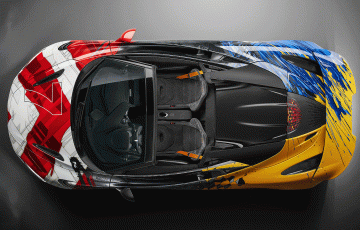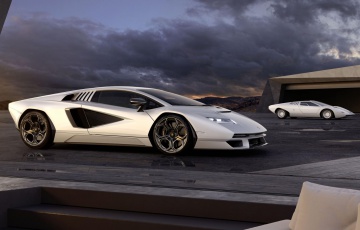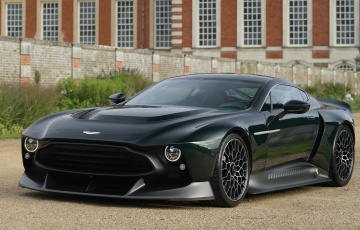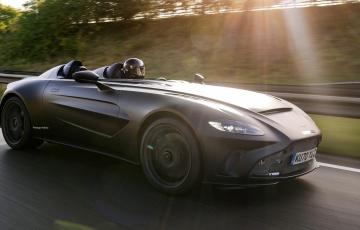We rode shotgun in Aston Martin's Vulcan. Here's how it felt

Groucho Marx famously opined that he would never be a member of a club that would have him as a member. But if he had a spare EU1.8m knocking about, even he would have taken one look at Aston Martin's Vulcan, wiggled his cigar, and said, 'Where do I sign?'
Officially the lowest car Aston has ever made ' it's just 1186mm tall ' TG.com has just become one of only a tiny handful of people to squeeze into this latest entry in the ultra-high end track car niche and is currently contemplating bank robbery as a result. The Vulcan isn't just insanely fast ' that much is obvious ' it's also an unbelievably special place to sit and ponder your extreme good fortune.
Like Ferrari's FXX Corse Clienti programme and McLaren's P1 GTR, the Vulcan isn't just about getting your rocks off on the world's best circuits, it's about being part of a band of car-loving brothers keen to mainline 800hp's worth of normally aspirated 7.0-litre V12 internal combustion, while chiselling away at your lap time.

This much is clear: as you fondle the saddle leather strap that pulls the door closed or twiddle the switches that govern the multi-stage traction control, at no point will you think, 'Well, this feels a bit like a 1980s eastern European hatchback'.
TG.com is at Paul Ricard, where the Vulcan is being given its first full run in front of a handful of owners and Aston dealers. Former McLaren F1 test driver and endurance racing star Darren Turner is currently buzzing the pit-lane, but even at the far end of this 3.6 mile-long track, the Vulcan makes the sort of noise you'd imagine an 800hp V12 with flame-spitting side-exit exhausts would dish up – wild enough to make a battle scene in Game Of Thrones sound like a round of University Challenge.
Money can buy you many things, of course, but not necessarily the talent required to make a Vulcan dance. Plopping a Russian oligarch in at the deep end would be deeply inadvisable. So clients start off in a V12 Vantage S, with an instructor alongside and the usual brake boards, and turn/apex/exit cones on the circuit to stop you making a complete tit of yourself.

This is fun enough around Paul Ricard, home to many French GPs, although its last few corners (double droite du Beausset and Virage de Bendor in particular) are a bit understeery and fiddlesome. Even with a chicane to slow things down, a fast road car can still find itself gasping somewhat on the 1.8 mile Mistral straight.
This is less of an issue in the next car we find ourselves in: only a flipping One-77. Clearly, you know you're having an above-average day when a One-77 is merely a waypoint to something much faster. Its front end immediately feels far keener than the Vantage's, and that still-stunning looking body checks itself much better as the lateral g builds.
The gearbox has always been the One-77 Achilles heel, though, and time and technology's march have not been kind to it. Still, by now you'll be hooking up Ricard's technical bits much more adroitly, and pinning the throttle onto the main straight seems almost natural. And you've just driven one of the world's premier supercars.

Next up is the Vantage GT4 race car. One word here: slicks. Suddenly, it all clicks, the lap times tumble, and you're hustling a 400bhp Aston race car like a go-kart. It'll let you take big bites out of the kerbs, and if you do screw up and back off mid-corner, the resulting slide is easily sorted. As ever, it'll brake far later and deeper than your brain thinks you can.
'You just shaved at least a second off your lap right there,' my instructor Andy tells me when I finally get it right.
Then it's Vulcan time. TopGear.com is only allowed to ride shotgun – for now – but we'll take it. In the flesh, the Vulcan really does look mind-blowing, the sort of thing a nine-year old boy would compare to a spaceship (mine did), or tempt a grown man to buy two examples of, one to drive and one to gawp at (someone has done just that ' sod the helicopter).

The front end is close to a full-on LMP1 car for tarmac-hoovering drama, while somehow preserving the trademark Aston face. Track cars need minimal lights, but the Vulcan's LEDs underline its menace.
There's a shark fin by the front wheelarches to dissipate the high pressure that builds there, and aid airflow. The rear diffuser is brutally functional by comparison, and the wing is big enough to double as a dinner table in a diplomatic residence.
The rear lights are stunning: 30 individual orange light-pipes that glow red. Those side-exiting exhausts don't just look and sound super cool, they also keep the rear end free of plumbing, leaving the diffuser to do its thing more or less unmolested.
The Vulcan uses the same carbon tub as the One-77, but Aston says it has been so extensively modified as to be effectively a new structure. Everything is made of carbon fibre, including the roof, and the Vulcan runs a full FIA roll cage. In fact, it meets all the criteria for an invitation race series except that it would wipe the floor with virtually all the competition, 'balance of performance' regs notwithstanding.

The single biggest challenge revolves around the Vulcan's aero package. The man in charge here is Graham Humphreys, a British motorsport lifer who began his career at Hesketh, and ran the 1995 Le Mans-winning McLaren F1, the 1999 BMW LM-winning car, and most recently worked on Bentley's Continental GT3 racer.
'We needed to make this car benign enough for anyone to drive it,' he explains, 'while running proper aero. We needed to deliver low pitch sensitivity, and to ensure that the centre of pressure is behind the centre of gravity. Basically, what you want is the maximum downforce in a controlled way, which is not the same thing as chasing maximum downforce.'
This also effectively makes Darren Turner the Vulcan's human 'control'. Every driver has his or her foibles when it comes to set-up, but it's Darren's job to arrive at as neutral and accessible a chassis balance as he can possibly achieve, without dialling out the entertainment quotient.

He also had a hand in the Vulcan's cockpit, though he's refreshingly honest about his input. 'When I first sat in it, I thought, 'f**k, this looks fantastic!' I wouldn't have had the imagination to come up with a cockpit that looks as good as this. I just told the guys where I thought everything should go, and they did it.' This includes standard indicator stalks, because that's where most of us still expect to find them.
Owners are initially limited to 500hp, but Turner, who has racked up about 90 per cent of the 7000 or so development miles Vulcan chassis zero has done, isn't messing about today. I can also tell you that his idea of warm-up lap is rather different to mine.
Normally, I'd say there's a limit to what you can really learn from the passenger seat, especially at 255km/h. But in this case, it's clear that Graham, Darren and the rest of the Vulcan team have done an awesome job.
Of course the Vulcan is cosmically, almost comically fast, but then we live in a world where Ferrari will sell you a front-engined road car ' not even its top-flight supercar ' with 780hp and a sub-3.0 second to 100km/h time.

No, the Vulcan has a different job to do. This is about big track thrills, and two things stand out. There's a corner at Ricard called Courbe de Signes – it's similar to Copse at Silverstone – through which you can feel the wing, scoops and diffusers work their magic. It's an incredible feeling, disconcerting at first if mechanical grip is your main bag. Imagine a giant hand arriving out of nowhere and pressing down on your head.
The Vulcan is also hugely impressive under hard braking and evidently has a fabulously exploitable chassis. Darren breaks traction a few times, and of course because he's set the damn thing up he knows exactly what it's going to do, where, and when.
But it really doesn't feel like a car that wants to chuck you into the Armco at the first possible opportunity. It's properly sorted. It also feels impressively robust, too.
'The operating window is pretty big,' Turner says as we glide back into the pit-lane. 'The transition from mechanical grip into aero isn't too severe. This is day three for me in it, and I've lost count of the miles I've racked up in it. But it's a brilliant thing to drive.'
It is. And he doesn't have to rob a bank to do it.









